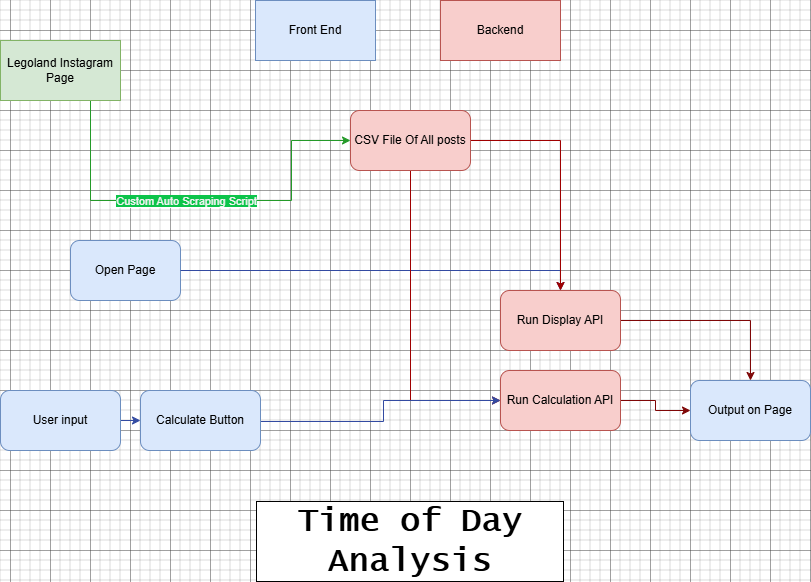Post Time Analysis

My Role: Optimal Post Timing Analyst Objective: Determine the best time of day to post on social media by analyzing post timing and engagement metrics. Provide data-driven recommendations to maximize audience reach and interaction.
User Story: As a marketing team member at Legoland developer, I want to analyze the impact of the times of posting based on the overall engagement of the post.
A key factor in social media engagement is timing—when a post is published can significantly impact how much attention it receives. As part of our broader initiative to increase Legoland’s social media engagement by 20%, my role focuses on analyzing the best times to post using real engagement data.
By leveraging Python, Machine Learning, and social media APIs, I will extract post timestamps, engagement metrics (likes, shares, comments), and audience activity patterns. Using time-series analysis and data visualization, I will identify trends that reveal the peak engagement windows for Legoland’s audience.
This analysis will contribute to our overall framework by: ✅ Determining optimal posting times to maximize visibility. ✅ Filtering irrelevant data to ensure accuracy. ✅ Providing a predictive scheduling model to forecast engagement based on historical trends. ✅ Delivering a visual dashboard to help the marketing team make data-driven content decisions.
By aligning content strategy with audience behavior, this approach ensures that Legoland’s social media efforts are more impactful, timely, and effective in fostering community engagement and healthcare awareness.
- Data Collection & Cleaning Purpose: Gather and preprocess social media post data, ensuring accuracy and removing irrelevant or misleading entries.
Key Responsibilities: Extract post time and engagement data from social media platforms using available APIs (e.g., Meta, X, YouTube, LinkedIn).
Filter out irrelevant content (e.g., test posts, ads, or unrelated uploads).
Normalize timestamps to account for different time zones and ensure consistency.
Remove anomalies (e.g., posts with abnormally low views due to deletion, glitches, or manual errors).
Insights & Outcomes: A clean dataset with accurate post times and engagement statistics.
A structured format for easy analysis and trend detection.
Elimination of misleading data that could distort results.
- Peak Engagement Analysis Purpose: Identify which times of day lead to the highest engagement levels.
Key Responsibilities: Group engagement metrics by time of day (morning, afternoon, evening, late night).
Analyze engagement trends across different weekdays and weekends.
Correlate posting time with likes, shares, comments, and watch time.
Rank posting times from most effective to least effective.
Insights & Outcomes: What time slots generate the most engagement?
Are there specific days of the week with higher/lower engagement?
Do engagement patterns differ by content type (e.g., health tips vs. patient stories)?
What are the least effective posting times that should be avoided?
- Engagement Impact & Predictive Modeling Purpose: Predict optimal posting times based on historical data.
Key Responsibilities: Use statistical models to predict future engagement trends based on past post performance.
Identify time-based engagement patterns (e.g., peak activity hours).
Determine if external factors (e.g., holidays, seasons, events) influence engagement.
Test different time slots (A/B testing) to refine posting strategies.
Insights & Outcomes: What posting time consistently leads to viral content?
How does audience engagement fluctuate over time?
Are there external trends influencing audience behavior?
What adjustments can be made to improve future engagement?
4. Deliverables 📊 Best Post Timing Dashboard
Visual timeline of optimal posting hours.
Engagement trend charts by time of day.
Day-of-week comparisons for best posting times.
Insights Report
Data-driven recommendations on when to post for maximum reach.
Breakdown of peak vs. off-peak hours.
Analysis of engagement patterns over time.
** Posting Schedule Strategy**
Suggested posting calendar based on findings.
Ideal posting frequency and time slots.
Strategy to test and refine best posting times.
How This Helps Legoland devlopment Maximizes engagement by targeting high-activity time slots. Eliminates guesswork in social media scheduling. Enhances content reach by aligning posts with audience behavior.